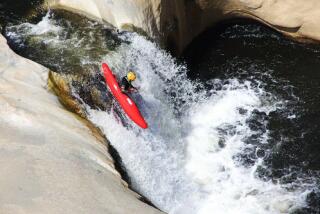‘Swooping’ toward a high-risk thrill
Reporting from Perris -- The competition was high-performance and high-risk, and Sean Carey and his 16 fellow skydivers knew it.
They were equipped with special parachutes that allowed a faster and better-controlled descent, and their goal Saturday was to dive toward a shallow pond in an advanced maneuver known as swooping.
One by one, they plummeted toward the surface, executing a last-minute turn to accelerate before leveling off and gliding just above the pond. But Carey, an instructor at Skydive San Diego who had done the maneuver successfully hundreds of times, made his turn too low and crashed into the pond.
Carey was the sixth highly experienced skydiver to be killed in the last year at Perris Valley Skydiving, one of the largest and most popular facilities for the sport in the nation.
The deaths reflect a divergent nationwide trend: equipment upgrades and safety rules have reduced overall skydiving fatalities among novices — but the smaller, more aerodynamically designed parachutes have allowed more experienced divers to take more risks.
Increasingly, industry veterans said, fatal accidents involve experts attempting advanced maneuvers with high-performance equipment — people like Carey, who according to his employer averaged 1,800 jumps a year and had won previous swooping competitions.
VIDEO: Perris Valley skydiving
Last December, another experienced canopy pilot, as they are known, died making a landing error while swooping at Perris. The facility temporarily suspended swooping while it conducted a review of safety procedures.
The company’s general manager, Dan Brodsky-Chenfeld, said he found that Perris’ safety standards were as high as or higher than other facilities’ but further tightened requirements.
The facility had already required that before attempting a high-performance maneuver, a skydiver must have made at least 700 jumps. After the December fatality, it added a requirement that skydivers receive special training before attempting swooping.
In the wake of Carey’s death, Brodsky-Chenfeld said he is again reviewing the standards.
High-risk maneuvers are clearly gaining the interest of top skydivers. Among the other daredevil moves is wingsuit flying, in which people glide across the sky in jumpsuits with fabric “wings” before deploying a parachute. Another is vertical formation skydiving, in which groups of skydivers grip one another’s limbs, their heads or feet pointed to the ground.
But many consider swooping to be the riskiest because the high-speed maneuvering is performed so close to the ground.
On Monday, parachutists at Perris Valley Skydiving — including some who witnessed Carey’s death Saturday — said they were shaken but not deterred.
“Bottom line is, this is the life we chose. We know this is dangerous,” said Joe Kaufman, an instructor at the facility, who has been skydiving for more than 20 years. Kaufman was not present when Saturday’s crash occurred.
Decades ago, industry experts said, fatal accidents involving faulty equipment were more common. Now, extra safeguards are in place and such accidents are rare.
In addition to a backup parachute, most skydivers — and all skydiving students — now carry an automatic activation device that will deploy the reserve parachute in the event of an emergency if the skydiver does not do so, said Nancy Koreen, a spokeswoman for the United States Parachute Assn.
The technological advances that have made the equipment safer have also allowed the development of faster, more sensitive canopies. Experienced skydivers compare the performance canopies used by advanced skydivers to race cars. Canopy pilots can reach speeds as high as 75 mph at the beginning of a swoop.
Out of 25 skydiving fatalities nationwide in 2011, six involved landing errors, which have accounted for an average of one-third of skydiving fatalities each year for the last decade, according to the Parachute Assn. Nearly all of those accidents involved highly experienced skydivers attempting advanced maneuvers, Koreen said.
There are no industrywide regulations on swooping. Each skydiving facility is left to establish its own rules, although Koreen said they are asked to restrict swooping to a separate landing area.
Skydive San Diego President Buzz Fink said Carey’s co-workers there — and skydivers around the nation — were distraught and shocked by his death, but Fink does not believe the Perris facility could have done more to prevent it. Carey was a skilled canopy pilot who made an error during a maneuver he had performed more than 1,000 times before, Fink said.
“Skydiving was his life,” he said. “He loved it, he enjoyed it and it was his passion in life.”
Los Angeles Times staff writer Ron Lin contributed to this report.
More to Read
Sign up for Essential California
The most important California stories and recommendations in your inbox every morning.
You may occasionally receive promotional content from the Los Angeles Times.










